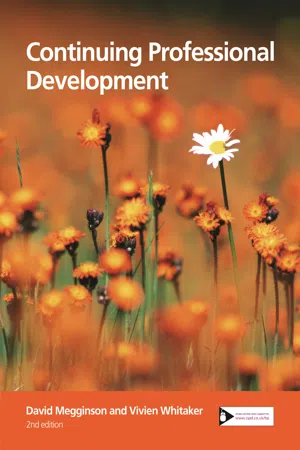![]()
PART 1
Exploring Continuing Professional Development
We start by engaging in the essential practical and theoretical exploration of Continuing Professional Development.
This will assist you to orient yourself to this subject and, in the course of doing so, will get you started on considering your own professional progress.
Within these two chapters are a series of questionnaires and activities. We encourage you to start a personal CPD log and include your responses to these exercises within it.
This log will help you to crystallise and summarise your view of CPD and link your learning from Part 1 to the range of activities in Parts 2 and 3 of this book.
In Part 2, the chapters are structured to take the reader through a development cycle. Chapter 3 focuses on assessing your current CPD agenda. Chapter 4 explores where you want to be. Chapter 5 looks pragmatically at action to achieve your aim and Chapter 6 helps you to review and evaluate your progress.
Part 3 will assist you in recognising and consolidating your CPD successes. It offers suggestions for increasing your networks and experimenting with a variety of methods for analysis and planning for your next cycle of CDP.
![]()
01
Clarifying Continuing Professional Development
INTRODUCTION
Continuing Professional Development (CPD) is a process by which individuals take control of their own learning and development, by engaging in an on-going process of reflection and action. This process is empowering and exciting and can stimulate people to achieve their aspirations and move towards their dreams.
CPD provides the opportunity to soar like an eagle or a helicopter and look at our career progress from a wider perspective. It challenges us to make time for regular personal reflection and review. It reminds us that we have the responsibility for developing ourselves rather than pushing the onus on to our manager or others in the organisation.
Remember the old saying, ‘You can take a horse to water but you can’t make it drink’? Our response to that is to say that CPD is about becoming thirsty – thirsty for new knowledge, thirsty for new skills, thirsty for new experiences.
THE NEED FOR CPD
The need for CPD arises because security for individuals no longer lies in the job or organisation we work for but in the skills, knowledge and experience that we have within ourselves.
Authoritative reports (Institute for Employment Studies – Tamkin et al, 1995; Industrial Relations Services, 1998; Income Data Services, 1999) highlight CPD as a major intervention that we can make into our own development.
CORE CONCEPTS OF CPD
What makes CPD different from other types of training and development?
The learner is in control – CPD starts from the learner’s dream.
CPD is a holistic process and can address all aspects of life and the balance between them.
Regularly looking forward to how we want to be, reflecting on how we are, and working from our present position towards the future direction, helps in achieving CPD’s purposes and adds zest and direction to work and learning.
CPD works if you have the support and financial backing of your employer, and it also works even if the employer is indifferent or hostile.
CPD is not a panacea – like anything else it must be looked at in relation to the rest of the individual’s life, the organisational context and the wider work environment.
STAKEHOLDERS INVOLVED IN CPD
There are several parties with an interest or stake in CPD. Centrally, there is yourself. We have written this book with the firm conviction that CPD works for individuals, and that it makes complete sense to engage with the process whether you are under pressure to do it from others or not.
Others are also arguing that CPD is important for you. Many employers see it as crucial to development. They use CPD as a means of giving power and focus to a range of HRD interventions.
Universities and colleges also use CPD to help learners link their curriculum to the relevant and often pressing concerns of current work, or their future career. Academic institutions also develop CPD in response to the requirements of professional bodies. These bodies advocate it as a way of supporting their members and as a means to underpin individual Charter membership.
The benefits of CPD for individuals
As individuals, many of us may not have had appropriate careers advice when young or may have jumped at the first job on offer. In the rush of our day-to-day existence we may not have given ourselves the chance to reflect and consider whether we are getting what we want in our professional lives.
Sadler Smith et al, 2000, found that the three main benefits of CPD for individuals were updating (maintenance), competence (survival) and enhanced mobility. How does this accord with your motives or those discussed elsewhere in this chapter?
The benefits of CPD for employers
Employers are increasingly concerned that employees undertake CPD, first, because it contributes to staff keeping their skills, knowledge and experience up to date. Secondly, many employers like staff to take responsibility for their own development...
